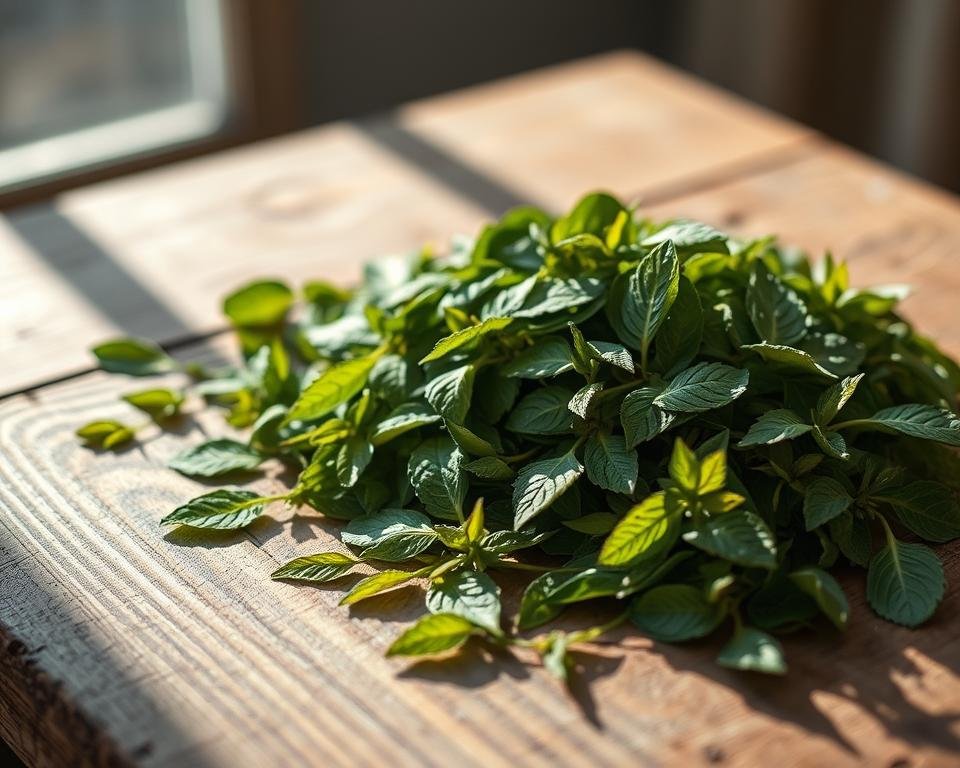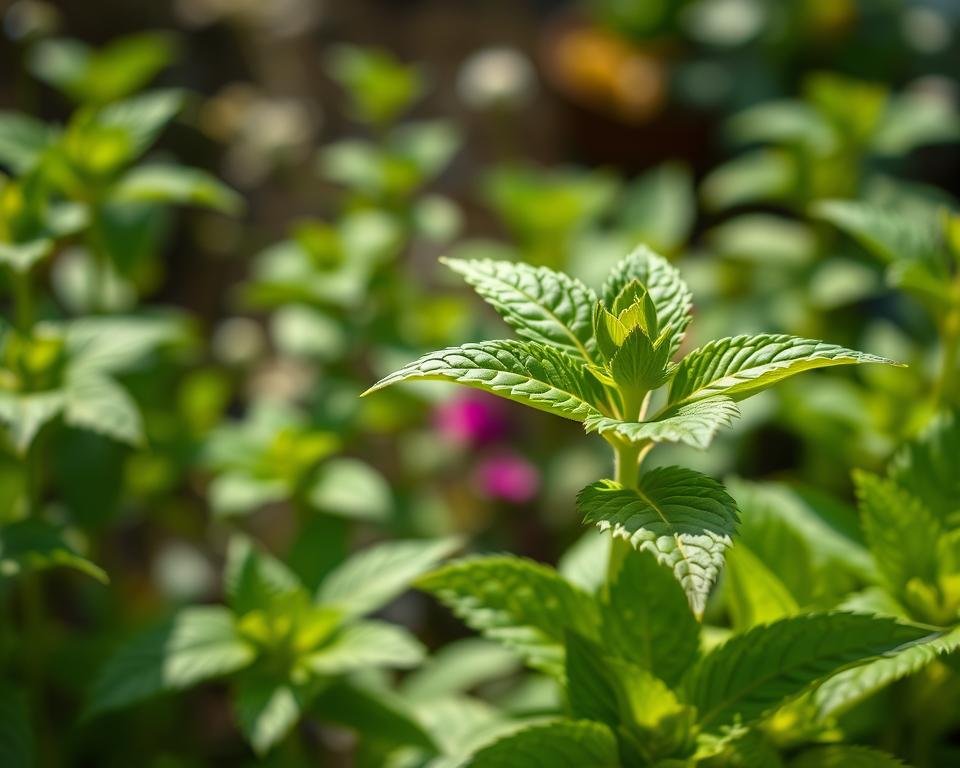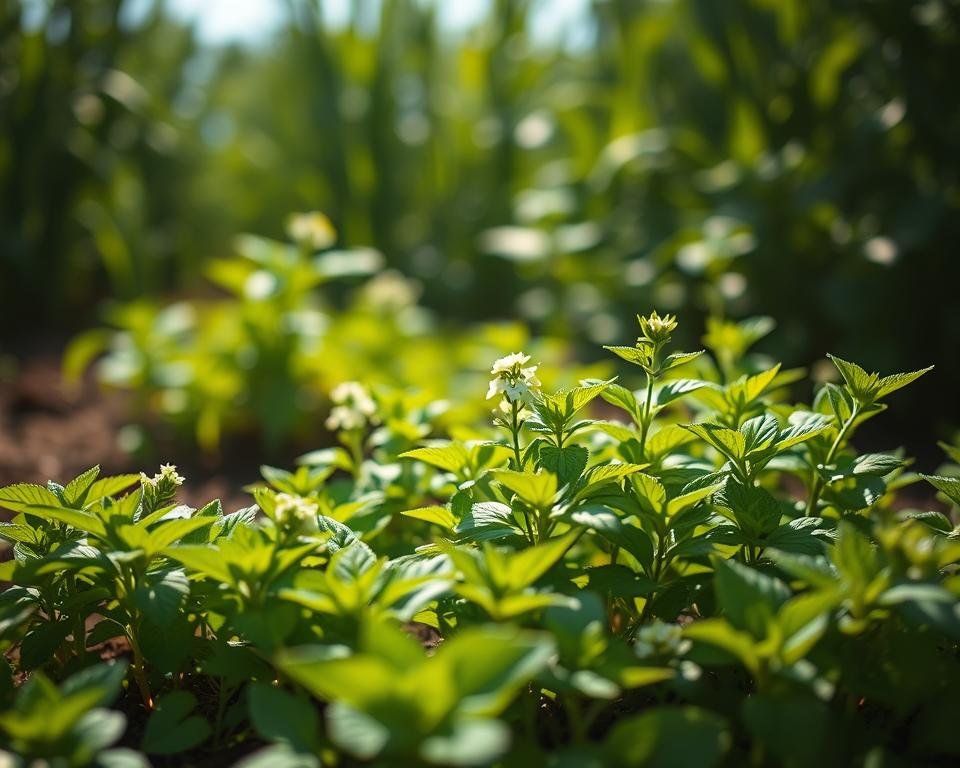Discover How to Grow Lemon Plant Herb Everyone Is Using
There’s something magical about stepping into a garden filled with fragrant herbs. Among them, lemon balm stands out with its bright, citrusy aroma and soft green leaves. This herb, part of the mint family, brings both flavor and wellness to our lives.
Lemon balm isn’t just another plant—it’s a multitasker. Its lemony-mint scent freshens the air, while its leaves enhance teas, salads, and desserts. Beyond the kitchen, it’s cherished for its calming properties, making it a favorite in herbal remedies.
Whether you’re a seasoned gardener or just starting, this guide will walk you through everything from planting to harvesting. Let’s explore why this herb deserves a spot in your garden.
Key Takeaways
- Lemon balm belongs to the mint family and offers a refreshing citrus-mint scent.
- It’s perfect for culinary dishes and natural remedies.
- The plant grows 24-36 inches tall with medium-textured leaves.
- Easy to cultivate, making it great for beginners.
- Harvesting tips ensure the best flavor and potency.
How to Grow Lemon Plant Herb Everyone Is Using: A Beginner’s Guide
Gardens flourish with life, but few herbs blend beauty and utility like lemon balm. This vibrant plant delights with its citrusy scent and lush leaves, making it a favorite for cooks and herbalists alike.
Why Lemon Balm Is a Must-Have Herb
Lemon balm’s charm lies in its versatility. Its Melissa officinalis leaves brighten teas, desserts, and salads. Beyond the kitchen, it soothes stress and aids sleep, proving its worth in home remedies.
Unlike invasive mint varieties, lemon balm stays manageable. It pairs well with other plants, thriving in gardens or containers.
Quick Facts About Lemon Balm
| Feature | Details |
|---|---|
| Botanical Name | Melissa officinalis |
| Height | 1–3 feet |
| Lifespan | 3–5 years |
| Leaves | Fuzzy, heart-shaped (green top/white underside) |
| Flowers | Tiny white/pink blooms in summer |
With minimal care, lemon balm rewards you for years. Its non-invasive nature and adaptability make it ideal for beginners.
Choosing the Right Location for Your Lemon Balm
Finding the perfect spot for lemon balm ensures lush growth and vibrant flavor. This hardy herb adapts well, but optimal conditions boost its performance. Let’s explore sunlight and soil needs to set the stage for success.
Sunlight Requirements: Full Sun vs. Partial Shade
Lemon balm loves sunshine but appreciates afternoon shade in hotter climates. Aim for 4–6 hours of direct light daily. Too much sun can scorch leaves, while too little reduces aroma.
Ideal Soil Conditions for Thriving Plants
Well-drained soil with a pH of 6.5–7.0 keeps roots happy. Clay-heavy ground? Mix in 3 inches of organic compost to improve texture. Avoid waterlogged areas—excess moisture invites root rot.
“Healthy soil is the foundation of every great garden.”
For containers, try a premium blend like Miracle-Gro® Performance Organics®. Test soil yearly and adjust pH with lime (to raise) or sulfur (to lower).
Planting Lemon Balm: Step-by-Step Instructions
Planting lemon balm is simple, but timing and spacing matter. A little planning ensures robust growth and vibrant foliage. Let’s dive into the essentials.
When to Plant: Spring After Last Frost
Wait until soil warms to 60°F, typically after the last frost. Early spring planting gives Melissa officinalis time to establish before summer heat. In colder zones, start seeds indoors 6–8 weeks prior.
Spacing and Depth for Optimal Growth
Proper spacing prevents overcrowding and mildew. Sow seeds ¼ inch deep, or transplant seedlings at their original nursery depth. Allow 20–24 inches between plants for airflow.
| Planting Method | Specifications |
|---|---|
| Seed Depth | ¼ inch |
| Spacing (Plants) | 20–24 inches |
| Row Spacing | 12–18 inches |
Group 3–5 plants for visual impact in herb gardens. Trim stems lightly after planting to encourage bushiness. For containers, choose pots at least 12 inches wide.
“Good spacing is the secret to healthy, disease-resistant herbs.”
Watering and Feeding Your Lemon Balm
Water and fertilizer form the foundation of vibrant lemon balm growth. This resilient herb forgives occasional neglect but rewards consistent care with lush foliage and intense aroma. Let’s explore the ideal hydration and nutrition plan.
Hydration Needs Through the Seasons
Young plants need weekly watering until established. Mature lemon balm thrives with 1–1.5 inches of water every 7–10 days. Check soil moisture by inserting a finger—water when the top inch feels dry.
In peak summer, increase frequency to prevent wilting. Container plants dry faster and may need watering every 3–4 days. Reduce hydration in fall as growth slows.
Nutrition for Maximum Vitality
A balanced 10-10-10 fertilizer works well for potted plants. For garden beds, side-dress with aged manure in early summer. Seaweed extract foliar feeds monthly boost leaf production.
| Feeding Method | Schedule | Product Options |
|---|---|---|
| Granular Fertilizer | Every 4 weeks | Miracle-Gro® Performance Organics® |
| Liquid Feed | Biweekly | Compost tea or fish emulsion |
| Soil Amendment | Spring/Fall | Worm castings or leaf mold |
Avoid high-nitrogen formulas that dilute flavor. Organic options like compost tea enhance soil health for years. Always water thoroughly after applying any fertilizer to prevent root burn.
“Feed the soil, not just the plant—healthy earth grows resilient herbs.”
Adjust feeding during dormancy. Stop fertilizing 6 weeks before first frost to harden plants for winter. Resume in spring when new growth appears.
Pruning and Maintaining Your Lemon Balm
Regular pruning transforms lemon balm from scraggly to spectacular. This resilient herb benefits from seasonal attention to stay productive for years. With simple techniques, we keep plants bushy and prevent unwanted spread.
Strategic Trimming for Lush Growth
Pinch back stem tips when plants reach 6 inches tall. This encourages branching and doubles leaf production. For mature Melissa officinalis, cut stems by one-third in early summer.
Always use clean shears to prevent disease. Focus on removing woody stems first, then shape the remaining foliage. Morning pruning reduces stress on plants.
Controlling Spread in the Garden
Lemon balm self-sows aggressively if flowers mature. Remove flower buds before they form seed heads. A 2-inch mulch layer suppresses volunteer seedlings.
For in-ground plants, install 12-inch root barriers. Check perimeter beds each spring for escaped runners. Divide crowded clumps every 3 years to maintain vigor.
| Maintenance Task | Frequency | Tools Needed |
|---|---|---|
| Tip Pruning | Monthly during growth | Clean fingers or snips |
| Flower Removal | When buds appear | Pruning shears |
| Root Division | Every 3 years | Spade and knife |
“A well-pruned lemon balm outproduces neglected plants three-to-one in essential oils.”
Watch for leggy growth—it signals need for more light or nutrients. Container plants require more frequent root checks. Always disinfect tools between plants to protect your whole garden.
Common Pests and Problems
Even the hardiest herbs face challenges, and lemon balm is no exception. While it’s resilient, pests and disease can weaken its vibrant growth. Early detection and simple fixes keep plants thriving.

Identifying and Managing Insects
Aphids and spider mites love Melissa officinalis. Look for curled leaves or sticky residue. Blast pests off with a hose or apply insecticidal soap weekly.
For severe infestations, neem oil works naturally. Introduce ladybugs—they’re aphid predators. Avoid broad-spectrum pesticides; they harm beneficial bugs too.
Disease Prevention Tips
Powdery mildew appears as white dust on foliage. Prevent it with proper spacing and morning watering. Treat outbreaks with a baking soda spray (1 tbsp per gallon).
Rust fungus shows as orange spots. Remove infected leaves and apply copper spray. Rotate planting locations every 4 years to protect soil health.
“Clean tools stop diseases from spreading—wipe blades with rubbing alcohol between cuts.”
| Issue | Signs | Solution |
|---|---|---|
| Aphids | Clusters on stems | Insecticidal soap |
| Powdery Mildew | White patches | Improve airflow |
| Root Rot | Wilting, black roots | Reduce watering |
Yellow leaves often signal overwatering. Check drainage and let soil dry slightly between sessions. Healthy plants resist pests better—feed and prune regularly.
Harvesting Lemon Balm for Maximum Flavor
The true magic of lemon balm unfolds when harvesting its fragrant leaves at peak potency. Timing and technique preserve its vibrant citrus notes and ensure the plant thrives for future harvests.
Prime Time for Picking
Morning is ideal—after dew evaporates but before heat dulls essential oils. For Melissa officinalis, target young stems with bright green leaves. Older foliage loses flavor intensity.
Pre-flowering stage offers the strongest aroma. Snip just as buds form but before they open. Revisit plants every 10–14 days for continuous yields.
Gentle Techniques for Healthy Plants
Use the “zipping” method: pinch a stem between thumb and forefinger, then slide downward to release leaves. This minimizes damage to tender growth.
For larger harvests, cut above leaf nodes at a 45-degree angle. Angled cuts shed water, preventing rot. Always sanitize tools with rubbing alcohol between plants.
| Harvesting Don’ts | Why It Matters |
|---|---|
| Removing >1/3 of foliage | Stresses the plant, slows regrowth |
| Cutting below leaf nodes | Reduces new stem production |
| Harvesting wet leaves | Promotes mold during drying |
“Harvest with respect—what you give to the plant, it returns tenfold in flavor.”
Post-harvest, water deeply and apply compost tea to support recovery. Healthy plants rebound quickly, offering multiple harvests per season.
Drying and Storing Lemon Balm
Preserving lemon balm’s vibrant flavor extends its usefulness beyond the growing season. With the right techniques, its citrusy notes enhance dishes, teas, and remedies year-round. Let’s explore how to lock in freshness.

Best Methods for Preserving Flavor
Air-drying works perfectly for lemon balm. Bundle 5–6 stems with twine and hang upside-down in a dark, well-ventilated space. Leaves crumble easily when fully dry—usually in 1–2 weeks.
For faster results, use a dehydrator at 95°F. Spread leaves in a single layer and check every hour. Low heat preserves essential oils better than oven drying.
“Crush a leaf—if it smells grassy instead of lemony, it’s over-dried.”
Creative Storage Solutions
Store dried leaves in airtight jars away from light. Glass jars with rubber seals work best. Label with dates; flavor peaks within 6 months.
For fresh-like taste, freeze chopped leaves in ice cube trays with water or olive oil. These cubes blend seamlessly into soups or sauces.
- Infuse: Steep leaves in vinegar or honey for dressings and glazes.
- Blend: Mix into compound butter for seafood or bread.
- Craft: Layer leaves with salt in jars for flavored seasoning.
Add dried lemon balm to herbal tea blends or homemade potpourri. Its versatility shines in both kitchen and craft projects.
Culinary Uses for Lemon Balm
Lemon balm brings bright citrus notes to any dish. Its fresh flavor enhances both sweet and savory recipes, making it a kitchen staple. Let’s explore creative ways to incorporate this versatile herb.
Fresh Leaves in Teas and Salads
Tear young leaves directly into iced tea or fresh salads. The citrusy aroma pairs well with mint and basil. For a refreshing twist, add chopped leaves to fruit salads or summer drinks.
Steep 5-6 leaves in hot water for 3 minutes to make a calming herbal tea. Combine with honey and ginger for extra warmth. Always use fresh leaves—they contain the highest oil content.
Cooking Tips and Tricks
This herb shines in cooking, especially with poultry and fish. Stuff whole sprigs inside chicken before roasting. The leaves infuse meat with delicate lemon notes without acidity.
For compound butter, blend softened butter with minced leaves and sea salt. Roll into logs and chill—perfect for grilled vegetables or crusty bread.
| Recipe Idea | Preparation Tip |
|---|---|
| Citrus-Herb Dressing | Whisk leaves with olive oil, lemon juice, and Dijon |
| Seasoning Salt | Mix dried leaves with coarse salt and lemon zest |
| Herb Ice Cubes | Freeze chopped leaves in water for summer drinks |
“Lemon balm transforms ordinary dishes with its sunny, aromatic touch.”
Add leaves at the end of cooking to preserve their vibrant flavor. Heat diminishes the essential oils, so garnish soups or pastas just before serving. Experiment with desserts—it pairs beautifully with berries and white chocolate.
Medicinal Benefits of Lemon Balm
Modern science confirms what herbalists have long known—lemon balm is a medicinal powerhouse. Its antiviral and calming properties make it valuable for both physical and emotional wellness. We’ll explore two standout applications that showcase its healing potential.

Soothing Teas for Relaxation
Steeping fresh leaves creates a calming brew that eases stress. The natural compounds in Melissa officinalis interact with brain receptors, promoting relaxation without drowsiness. For best results, use 2 tablespoons of crushed leaves per cup of hot water.
Natural Cold Sore Solutions
Research shows lemon balm can reduce cold sores outbreak severity by 70%. Its active compounds block the virus that causes these painful blisters. Apply these remedies at the first tingling sensation:
- Fresh poultice: Crush leaves and press directly on affected areas
- Infused oil: Mix with beeswax to create healing lip balm
- Tincture blend: Combine with licorice root for extra infection protection
“Lemon balm’s rapid action on herpes simplex makes it my first-choice botanical intervention.”
For mouth ulcers, try swishing with a strong tea infusion. The herb’s healing properties work on multiple types of oral irritation.
Growing Lemon Balm in Containers
Container gardening unlocks new possibilities for lemon balm enthusiasts. Whether you have a tiny balcony or limited garden space, pots let you enjoy this aromatic herb anywhere. With a few adjustments, your potted plants will flourish.
Choosing the Right Pot and Soil
Select containers at least 12 inches wide with drainage holes. Terra cotta breathes better than plastic, preventing soggy roots. For soil, mix equal parts potting mix, perlite, and compost.
Sunlight needs remain similar—place pots where they’ll get 4–6 hours of morning sun. Rotate weekly for even growth. Elevate pots on saucers filled with pebbles to boost humidity.
Care Tips for Potted Plants
Check water needs daily in summer. Containers dry faster than garden soil. Water until it drains freely—never let roots sit in standing water.
Feed monthly with slow-release fertilizer or liquid seaweed. Overwinter pots in cool basements (40–50°F) with sparse watering. Come spring, prune roots lightly before repotting.
| Container Challenge | Solution |
|---|---|
| Wind damage | Group pots or use trellis screens |
| Overheating | Wrap pots in burlap or light colors |
| Root crowding | Divide every 2 years |
“A well-tended pot of lemon balm yields enough leaves for weekly teas and recipes.”
Protect containers from strong winds that can topple tall stems. Harvest often to encourage bushiness—your windowsill garden will thrive with these simple steps.
Conclusion
This citrus-scented herb thrives with minimal effort, rewarding gardeners generously. Whether in a garden bed or pot, Melissa officinalis adapts easily to any space.
Remember the basics: well-drained soil, morning sun, and occasional pruning. Its versatile leaves shine in teas, dishes, and remedies—experiment freely!
Share your harvest photos online. Tag fellow herb lovers to spread the joy. For seasonal care, mark your calendar:
- Spring: Divide crowded clumps
- Summer: Harvest before flowering
- Fall: Dry leaves for winter
Low-maintenance and easy, lemon balm proves that great flavors need no fuss. Happy gardening!







